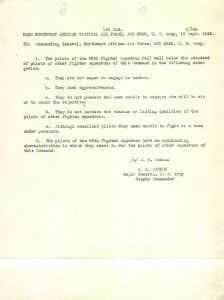Discrimination continued in 1943. The all-black 99th Fighter Squadron overseas was attached to various white fighter groups, since there was not yet a black fighter group overseas to which it could be assigned (the 332d Fighter Group would not deploy to the Mediterranean Theater until 1944). One of the groups to which the 99th was attached was the 332nd Fighter Group, whose commander was not happy having a black unit attached to his group, which already had three white fighter squadrons assigned to it. That commander was then Colonel William Momyer. As a result of his recommendations, Major General Edwin J. House of the XII Air Support Command sent a memorandum dated 16 September 1943 to Major General J. K. Cannon which called into question the combat efficiency of the 99th Fighter Squadron. The memorandum claimed that “the consensus of opinion seems to be that the negro type has not the proper reflexes to make a first-class fighter pilot.” It went on to recommend reassignment of the 99th Fighter Squadron away from the front lines. General Cannon seconded the House memorandum with one of his own, dated, 18 September 1943, which he in turn forwarded to Lt. Gen. Carl Spaatz, commander of the Northwest African Air Forces. Cannon noted “The pilots of the 99th Fighter Squadron fall well below the standard of other fighter squadrons of this Command…” Spaatz forwarded the House and Cannon memoranda on to Gen. Henry “Hap” Arnold on 19 September 1943, noting his “full confidence in the fairness of the analysis made by both General Cannon and General House.”
After the memoranda of Generals House, Cannon, and Spaatz reached General Arnold, the War Department launched a study to compare the combat performance of the 99th Fighter Squadron with the other P-40 squadrons in the Mediterranean Theater. In the meantime, the 99th Fighter Squadron was attached to other white fighter groups besides the 332nd, and with them it had more opportunities and more success. When the War Department study was finally released, at the end of March 1944, it had the title “Operations of the 99th Fighter Squadron Compared with Other P-40 Aircraft Squadrons in the MTO (Mediterranean Theater of Operations), 3 July 1943-31 January 1944.” The War Department study, from the Statistical Control Division, Office of Management Control, implicitly refuted the House, Cannon, and Spaatz memoranda of the previous year, and claimed that the 99th Fighter Squadron pilots performed in combat as well as their white counterparts.
By one measure, an argument could be made that instead of proving their inferiority in combat, the Tuskegee Airmen actually performed better than their white counterparts. The 99th Fighter Squadron was eventually assigned to the all-black 332d Fighter Group in Italy in mid-1944. During the period from June 1944 through April 1945, the 332d Fighter Group flew primarily bomber escort missions for the Fifteenth Air Force. It was one of seven fighter escort groups, four of which flew P-51s and three of which flew P-38s for most of that period. During that period, 27 bombers under Tuskegee Airmen escort were shot down by enemy aircraft. The Fifteenth Air Force lost a total of 303 bombers to enemy aircraft during the period. Subtracting 27 from that number leaves 276. Dividing that number by six gives the average number of bombers lost by each of the other fighter groups: 46. The Tuskegee Airmen lost significantly fewer bombers than the other fighter groups in the Fifteenth Air Force during the same period. Moreover, the Tuskegee Airmen flew 179 bomber escort missions for the Fifteenth Air Force, and lost bombers on only seven of those missions. If these were the only statistics we consider, we might conclude that the 332d Fighter Group performed better than the other groups.


